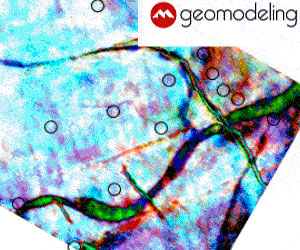Articles

Alberta Labour’s Provincial Seismic Program
Jim Shaffer
Alberta Labour has identified six specialized program areas in its Business Plan for 1995. The specialized program areas include Seismic, Residential Construction, Forestry, Steel and Iron Foundries, Mining and Trenching.
...
1996 Election of Officers Candidates
Overview of the 1996 CSEG Executive election candidates.
...
Effective Geophysical Writing and Presentation
Robert R. Stewart, R. James Brown and Don C. Lawton
James Michener (1992) wrote, "The writer who sits at his or her desk with an empty piece of paper staring back is like the explorer who stands at the edge of a new continent, uncertain of how to proceed" – an exciting but perhaps difficult position. The goal of this…

The Doodlebugs
Sharon Stevens
A doodlebugger? What is a doodlebug and where did that name come from? A definitive answer was what I was searching for. But a variety of responses is what I found...
...
Depth Imaging of Seismic Data from Structurally Complex Areas
Larry Lines, Wen-ling Wu, Han-Xing Lu, Andrew Burton, and Jinming Zhu
Recent geophysical research has made widespread use of depth migration and velocity analysis in our efforts to improve seismic images in structurally complex areas. Such structural exploration problems include the imaging of salt intrusions and faulted structures from offshore Newfoundland, and the delineation of thrust faulted structures from the Alberta…

From Horses to Helicopters: Bill Sydorko's 45-year Career in Seismic Field Work Mirrors an Industry's Coming-of-age
Samantha-jane Mugridge
Bill Sydorko has progressed from working on geophysical crews of four or five men in 1950 to supervising crews of up to 30 men during the 1980s and 90s. Where 16 or 24 traces per seismic record were once standard, now he routinely deals with a minimum of 144 per…

3-D Prestack Time Migration of Canadian Plains Data: When and Why It is Needed
Mike Perz and Peter Cary
Today's generation of superscalar workstations and high performance supercomputers allows full prestack time migration of 3-D data volumes within a time frame that is manageable from the explorationist's viewpoint. Most geophysicists are aware that performing prestack time migration on structured data sets offers certain advantages, particularly from the viewpoint of…

Applied AVO Analysis: Use and Abuse of Amplitude Variation with Offset
John P. Castagna
The great promise of amplitude-versus-offset (AVO) analysis lies in the dependence of the offset-dependent-reflectivity of reflected compressional waves on the elastic properties of the subsurface. As different lithologies may exhibit distinct Poisson's ratios, and gas bearing strata usually exhibit anomalously low Poisson's ratios, AVO has been recognized as a potential…

Why Perform 3-D Prestack Time migration on the Prairies?
Mike Perz
Hardware platforms have now achieved a level of sophistication which permits the use of full 3-D prestack time migration as a production-style processing tool. While most geophysicists are aware that performing 3-D prestack time migration on structured data sets offers certain advantages, particularly from the viewpoint of velocity analysis, many…

Interpretation of Aeromagnetic Data
Erwin Ebner, John Peirce and Nathalie Marchand
The previous three articles of this series on Potential Field (PF) Geophysics dealt with recent technical improvements in magnetics and gravity instrumentation as well as with critical components concerning data acquisition and PF project management. This article focuses on processing and interpretation of aeromagnetic data. Key aspects of each of…

The CSEG Internet Services
Howard G. Hepburn
...
Project Planning and Management for Magnetic Gravity Surveys
Erwin Ebner
The first two articles of this series on potential field (PF) geophysics dealt with recent technological improvements in gravity and magnetics survey systems. This article addresses issues from a project management perspective where questions such as Why are we doing this? What are we going to get out of it?…

Using Geostatistics to Aid in Reservoir Characterization
Sheldon B. Gorell
Proper characterization of reservoir heterogeneities is a well recognized requirement to predict reservoir performance accurately. Given the large investment requirements, long development schedules, and the often uncertain economic outlook, sound decision making requires reasonable estimates of how much, and when, oil will be produced. It is no longer sufficient to…

Field Comparison Between 16 and 24 Bit Data Acquisition Systems
John H.J. Paquette and Tony Sartorelli
A test survey was recently conducted to compare the relative performance of three types of seismographs. The equipment used was a DFS/v (Texas Instruments), an I/O System Two (Input/Output, Inc.), and a Bison 24000 (Bison Instruments, Inc.).
...
The New Wave
Dr. Thomas L. Davis
Increased efficiency of finding and developing hydrocarbon resources while reducing the environmental impact through geophysical technology is critical to the future of the petroleum industry. This technology must remotely determine rock-fluid property characteristics, their geometry, and changes over time. In reviewing advancements in exploration seismology, three component 3-D seismology stands…

3-D, 3-C Seismic Characterization of the Nisku Carbonate Reservoir, Joffre Field, South-Central Alberta
John Arestad, Bruce Mattocks, Thomas Davis and Robert Benson
The Reservoir Characterization Project (RCP) at the Colorado School of Mines has pioneered research into 3-D, 3-C (multicomponent) reflection seismology for nearly a decade utilizing both P-wave and S-wave sources. Multicomponent seismic surveys provide significantly more information about petroleum reservoirs than compressional wave surveys.
...
Using Amber to Probe the Past: from DNA to Dinosaurs
Ever since Pliny the Elder concluded that amber originated from the resin of extinct trees, humans have been fascinated with the presence of life forms in this magical material. What we do know about the formation of amber will be discussed, along with the characteristics of the enclosed fossils.
...
Satellite Navigation: Present Capabilities and Future Trends
Elizabeth Cannon
he use of satellites for positioning and navigation has become an important tool for scientists and engineers concerned with locating and monitoring various features and phenomenon. The Global Positioning System (GPS) is a twenty-four satellite system which provides global, all-weather, twenty-four hour a day navigation capability. The elements of the…

Recent Advances in Gravity Acquisition and Instrumentation – Part II
Very high quality gravity surveys have been carried out for nearly half a century now. I have personally seen small gravity survey results from the late 1940's which rival present day quality. The main reason for this lies in the care with which these surveys were acquired. It took considerable…

A New Prospective on Pre-stack Migration Using Equivalent Offset and Common Scatter Point (CSP) Gathers
Dr. M. Elizabeth Cannon
A new process allows prestack migration to be simplified into the three steps of trace gathering, normal moveout, and stacking. This new method has many advantages that range from reduced processing times to more accurate velocity analysis.
...








